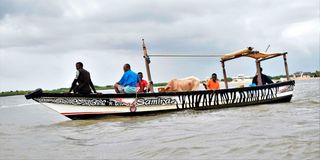Why feeding Lamu island is no walk in the park

Residents of Lamu cross from Manda Bay to Lamu Island in this picture taken on July 4, 2022.
What you need to know:
- Ali Abdalla, a cargo shipper in Lamu, said they prefer using the smaller boats as they are affordable.
- “We’re aware that large boats provide safer travel at sea but we can’t afford them. Very few individuals can purchase those bigger vessels.”
- A report by the fisheries and sea transport department in Lamu indicates that between 12 and 15 people die in marine accidents in the county annually.
Small boat operators daily risk life and limb to deliver foodstuff to residents living of the many islands that make up the Lamu archipelago in the vast Indian Ocean.
The vessels are often heavily-laden with sackfuls of cargo as they struggle to make a way through the tides whether day or night.
Occasionally, these journeys result in accidents, loss of property and death.
One such incident was reported last Saturday when two boats capsized off Wiyoni area. Fortunately, all crew were rescued by officers from the Kenya Coast Guard Services.

Lamu County Disaster Management Unit Director Shee Kupi.
Ali Abdalla, a cargo shipper in Lamu, said they prefer using the smaller boats because they are affordable.
“We are well aware that larger boats provide safer travel at sea but we can’t afford them. Only a few moneyed individuals can purchase those bigger vessels. We’re forced by circumstances to bear the risk of using these smaller vessels for transporting even much bigger stuff,” Abdalla added.
To own one such boat would cost between Sh1.5 million and Sh2 million to build and it takes less than a month to assemble.
Larger boats, also known as water buses, however, cost between Sh2.5 million and Sh5 million, and take three to six months to construct. They have a large bottom surface area, giving them the ability to remain stable even in the harshest of conditions at sea.
Suleiman Aboud, another cargo shipper plying the Lamu Island-Lamu East route says using smaller boats to ferry cargo is akin to a time-bomb waiting to explode.
“It only takes a slight roll by tidal waves for a boat to capsize, especially if it is overloaded. Small boats are unstable but many operators would rather risk their lives than stay without work,” said Mr Aboud.
The shippers dealing in agricultural produce normally overload their vessel as they prefer maximise returns by hiring just one boat to ferry as many large consignment as it can carry on a single trip.
Lamu’s mode of transportation is mostly sea-borne as the county is made up of numerous islands located in farflung areas separated by and held together by the vast Indian Ocean.
Lamu County Disaster Management Unit Director Shee Kupi says his office reports at least four cases of smaller boats capsizing while carrying agricultural produce every month.
Mr Kupi added that it was rare for such accidents to befall one of the large vessels as they are of a stabler proposition in the face of choppy seas.
He cited poverty as a key reason behind shippers using smaller boats that they can afford.
He also cited ignorance by the transporters on safety in the sea as contributing to frequent maritime accidents.
Mr Kupi said his office has been engaging the cargo shippers to turn to specialized boats for carrying farm produce and added that the county government of Lamu has already procured a special boat for farm produce movement (MV Kilimo).
To enhance safety at sea, Kenya Maritime Authority (KMA) has been holding training on marine safety for coxswains in Lamu and across the Coast region.
KMA Director General Martin Dzombo Munga said the agency’s key objective in undertaking training and issuing certificates to seafarers is to enhance maritime transport safety across the country.
“With a well-trained and certified coxswain population in Lamu, Coast and Kenya, we can drastically reduce the number of accidents, loss of life, property, and livelihoods, thereby sustainably improving the economy and well-being of the society and the nation at large,” said Mr Munga.
A report by the fisheries and sea transport department in Lamu indicates that between 12 and 15 people die in marine accidents in the county annually.
Notable accidents involve cargo vessels, particularly those ferrying agricultural produce such as the April 2021 incident where one person died while two were rescued when a boat carrying over 60 bags of potatoes, onions, kales, cabbages and other produce capsized at the Wiyoni-Tusitiri area in Lamu.
In June 2020, six people cheated death after three small boats capsized at Ashuwei near the deadly Mlango wa Tanu channel in Mkokoni, Lamu East.
In July 2023, one person died and two others rescued after their boat capsized at the Shee-Mwanasha channel near the deadly Mlango wa Tanu Channel in Lamu East.





